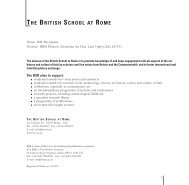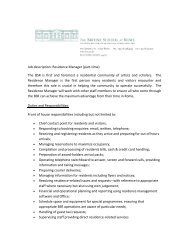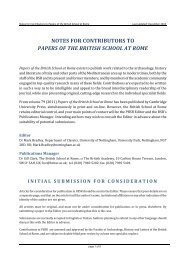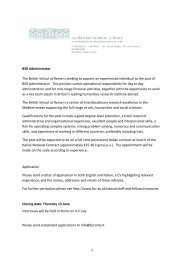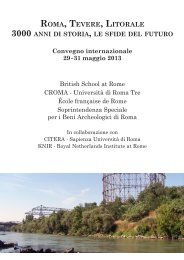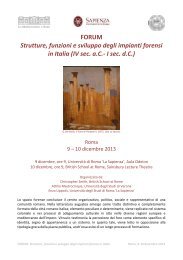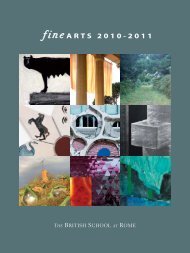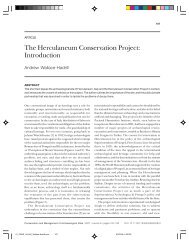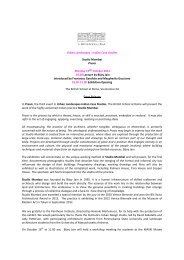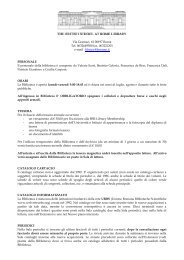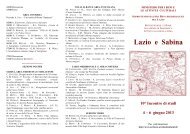Notes to PBSR contributors - The British School at Rome
Notes to PBSR contributors - The British School at Rome
Notes to PBSR contributors - The British School at Rome
Create successful ePaper yourself
Turn your PDF publications into a flip-book with our unique Google optimized e-Paper software.
<strong>Notes</strong> <strong>to</strong> Contribu<strong>to</strong>rs <strong>to</strong> the Papers of the <strong>British</strong> <strong>School</strong> <strong>at</strong> <strong>Rome</strong> Last up-d<strong>at</strong>ed: September 2009<br />
NOTES TO CONTRIBUTORS TO<br />
PAPERS OF THE BRITISH SCHOOL AT ROME<br />
GENERAL NOTE<br />
Articles for consider<strong>at</strong>ion for public<strong>at</strong>ion in the Papers should be sent <strong>to</strong> the Edi<strong>to</strong>r (see below). Please ensure<br />
th<strong>at</strong> your details are on a separ<strong>at</strong>e sheet, and th<strong>at</strong> on the article itself the author’s name, institutional affili<strong>at</strong>ion<br />
or any other indic<strong>at</strong>ion of the identity of the author are not given.<br />
All articles must be original, and must not be under consider<strong>at</strong>ion for public<strong>at</strong>ion, or in press,<br />
elsewhere. By submitting a paper <strong>to</strong> the Edi<strong>to</strong>r you are indic<strong>at</strong>ing th<strong>at</strong> this is the case.<br />
Submissions are normally accepted in English and Italian. Authors planning <strong>to</strong> submit in any other<br />
language should discuss this with the Edi<strong>to</strong>r in advance.<br />
Contributions <strong>to</strong> the Papers are assessed and approved by the Faculty of Archaeology, His<strong>to</strong>ry and Letters<br />
of the <strong>British</strong> <strong>School</strong> <strong>at</strong> <strong>Rome</strong>, and are subject <strong>to</strong> double-blind peer review by <strong>at</strong> least two specialist readers.<br />
<strong>The</strong> diverse content of the Papers presents problems of uniformity in the style of present<strong>at</strong>ion of articles.<br />
<strong>The</strong> first priority is clarity and this may in some cases mean divergence from the standards set out below.<br />
Consistency within a paper is of prime importance. None the less, it is expected th<strong>at</strong> contribu<strong>to</strong>rs will, so far as is<br />
possible, follow these instructions. Expense and time will then be saved both for contribu<strong>to</strong>rs and for the Papers.<br />
SUBMISSION<br />
TEXT<br />
Initial submissions may be in hard copy or as an e-mail <strong>at</strong>tachment. Articles should be double-spaced, with<br />
good margins. If submitted electronically, any figures should be supplied (<strong>at</strong> an appropri<strong>at</strong>e resolution) as part<br />
of the same document as the text or as <strong>at</strong> most one separ<strong>at</strong>e document. If submitted as hard copy, the article<br />
should be on one side of the paper and three copies should be supplied (including pho<strong>to</strong>copies of the<br />
illustr<strong>at</strong>ions). <strong>The</strong> Edi<strong>to</strong>r will return any article th<strong>at</strong> is considered <strong>to</strong> be unclear for retyping/reform<strong>at</strong>ting.<br />
Contribu<strong>to</strong>rs are strongly advised <strong>to</strong> keep a copy of the text as submitted. Once accepted, final versions of<br />
articles should be submitted both as a hard copy and as computer file(s).<br />
FOOTNOTES<br />
<strong>The</strong>se should be numbered consecutively through the text (and not with a new sequence for each new page). <strong>Notes</strong><br />
should start <strong>at</strong> 1, and not include, for example, a first note marked by a symbol. Footnotes must not be used simply<br />
for Harvard system references — these should be given in the text, within parentheses.<br />
BIBLIOGRAPHICAL REFERENCES<br />
Authors may use the Harvard (Author-d<strong>at</strong>e) System OR the Short Title System.<br />
HARVARD (Author-d<strong>at</strong>e) SYSTEM<br />
All works cited should be listed (alphabetically by author’s surname; if necessary divided in<strong>to</strong> primary and<br />
secondary sources) in full in a separ<strong>at</strong>e bibliography. In the text works should then be cited by author’s<br />
surname, year of public<strong>at</strong>ion, and page reference (if applicable). References should be placed in the text, r<strong>at</strong>her<br />
than given as notes (although notes may of course be used for additional comment). Here are some examples of<br />
the style <strong>to</strong> be used.<br />
page 1 of 8
<strong>Notes</strong> <strong>to</strong> Contribu<strong>to</strong>rs <strong>to</strong> the Papers of the <strong>British</strong> <strong>School</strong> <strong>at</strong> <strong>Rome</strong> Last up-d<strong>at</strong>ed: September 2009<br />
Arthur, P. (1985) Settlement and Land-use in Northern Campania during the L<strong>at</strong>e Iron Age and the Roman<br />
Period: the Massico and the Garigliano Basin. University of London, Ph.D. thesis.<br />
Barker, G. and Hodges, R. (1981) (eds) Archaeology and Italian Society (<strong>British</strong> Archaeological Reports,<br />
Intern<strong>at</strong>ional Series 102). Oxford, <strong>British</strong> Archaeological Reports.<br />
Brothwell, D. and Higgs, E. (1969) (eds) Science in Archaeology (second edition). London, Thames and<br />
Hudson.<br />
Herlihy, D. (1967) Medieval and Renaissance Pis<strong>to</strong>ia. <strong>The</strong> Social His<strong>to</strong>ry of an Italian Town, 1200–1430.<br />
London/New York, Yale University Press.<br />
Krautheimer, R. (1937–77) Corpus Basilicarum Christianarum Romae, 5 vols. V<strong>at</strong>ican City, Istitu<strong>to</strong> di<br />
Archeologia Cristiana.<br />
Plog, S., Plog, F. and Wait, W. (1978) Decision-making in modern surveys. In M.B. Schiffer (ed.), Advances in<br />
Archaeological Method and <strong>The</strong>ory I: 383–482. New York, Academic Press.<br />
Reece, R. (1982) <strong>The</strong> coins, in D. Whitehouse, G. Barker, R. Reece and D. Reese, <strong>The</strong> Schola Praeconum I: the<br />
coins, pottery, lamps and fauna: 55–6. Papers of the <strong>British</strong> <strong>School</strong> <strong>at</strong> <strong>Rome</strong> 50: 53–101 plus pl<strong>at</strong>es 3–5.<br />
Steinby, E.M. (1999) Scalae Graecae. In E.M. Steinby (ed.), Lexicon Topographicum Urbis Romae IV (P–S):<br />
241–2. <strong>Rome</strong>, Quasar.<br />
von Falkenhausen, V. (1983) Il duca<strong>to</strong> di Gaeta. In G. Galasso (ed.), S<strong>to</strong>ria d’Italia III: 348–9. Turin, UTET.<br />
Wickham, C. (1984) <strong>The</strong> other transition: from the ancient world <strong>to</strong> feudalism. Past and Present 103: 3–36.<br />
Please note the following additional points.<br />
Multiple references <strong>to</strong> the same author and year: these should be labelled, for example, 1985a and 1985b (not<br />
1985 and 1985a).<br />
References in text should take the following forms:<br />
‘… as was noted by Smith (1967: 24) …’<br />
‘… this point has been made (Smith, 1967: 24) …’<br />
‘… as Smith (1967; 1968) has shown …’<br />
‘ … (Plog, Plog and Wait, 1978) …’<br />
‘ … (Whitehouse et al., 1982) …’<br />
Multiple references <strong>to</strong> different authors: these should be given in chronological order, with the earliest first, for<br />
example, (Herlihy, 1967; Arthur, 1985; Herlihy, 2005).<br />
SHORT TITLE SYSTEM<br />
Books and articles should <strong>at</strong> their first cit<strong>at</strong>ion be cited in full, with complete bibliographical details. Some<br />
examples of the style <strong>to</strong> be used follow.<br />
P. Toubert, Les structures du L<strong>at</strong>ium médiéval. Le L<strong>at</strong>ium méridional et la Sabine du IXe siècle à la fin du XII siècle<br />
(Bibliothèque des Écoles Françaises d’Athènes et de <strong>Rome</strong> 221) (<strong>Rome</strong>, 1973), 490–502, esp. p. 495.<br />
J.F. Guiraud, ‘Le réseau de peuplement dans le duché de Gaète du Xe au XIIIe siècle’, Mélanges de l’École<br />
page 2 of 8
<strong>Notes</strong> <strong>to</strong> Contribu<strong>to</strong>rs <strong>to</strong> the Papers of the <strong>British</strong> <strong>School</strong> <strong>at</strong> <strong>Rome</strong> Last up-d<strong>at</strong>ed: September 2009<br />
Française de <strong>Rome</strong>. Moyen Âge–Temps Modernes 94 (1982), 489.<br />
G. Barker and R. Hodges (eds), Archaeology and Italian Society (<strong>British</strong> Archaeological Reports, Intern<strong>at</strong>ional<br />
Series 140) (Oxford, 1982).<br />
V. von Falkenhausen, ‘Il duca<strong>to</strong> di Gaeta’, in G. Galasso (ed.), S<strong>to</strong>ria d’Italia III (Turin, 1983), 348–9.<br />
R. Krautheimer, Corpus Basilicarum Christianarum Romae, 5 vols (V<strong>at</strong>ican City, 1937–77), I, 137–43.<br />
E.M. Steinby, ‘Scalae Graecae’, in E.M. Steinby (ed.), Lexicon Topographicum Urbis Romae IV (P–S) (<strong>Rome</strong>,<br />
1999): 241–2.<br />
At subsequent occurrences the reference should be shortened: for example,<br />
Toubert, Les structures du L<strong>at</strong>ium médiéval (above, n. 7), 17<br />
Guiraud, ‘Le réseau de peuplement’ (above, n. 5), 488<br />
von Falkenhausen, ‘Il duca<strong>to</strong> di Gaeta’ (above, n. 3), 349<br />
Krautheimer, Corpus Basilicarum (above, n. 4), II, 340.<br />
Abbrevi<strong>at</strong>ions, for example for journal titles in notes, may be used if the full title appears very frequently.<br />
Wherever possible, those given in L’Année Philologique, supplemented where necessary by those given in the<br />
American Journal of Archaeology, should be used. When an abbrevi<strong>at</strong>ion is not given there, the abbrevi<strong>at</strong>ion(s)<br />
used should be listed in the article, usually as part of the first note.<br />
If references are very frequent, abbrevi<strong>at</strong>ions for classical authors and works may be used. <strong>The</strong>se should follow<br />
those given in the l<strong>at</strong>est edition of <strong>The</strong> Oxford Classical Dictionary.<br />
<strong>The</strong> use of ibid., idem, op. cit., art. cit., loc. cit. must be avoided.<br />
GENERAL<br />
References in English: in book titles initial capitals should be used for all main words; in article titles initial<br />
capitals should be used only for proper nouns (see examples above).<br />
References in Italian: initial capital letters should be used only for proper nouns in book and article titles.<br />
References in German: initial capital letters should be used for all nouns in article titles; otherwise as for<br />
English.<br />
References in French: initial capital letters should be used only for proper nouns in book and article titles.<br />
Names of periodicals: capital letters should be used for all nouns and adjectives in all languages.<br />
Volume numbers: for periodicals, arabic figures should be used; for books in more than one volume, upper case<br />
Roman should be used. <strong>The</strong> word volume/vol. should be omitted.<br />
Page numbers: ‘p’ and ‘pp’ should be omitted unless they are absolutely essential for clarity. <strong>The</strong> exception is<br />
th<strong>at</strong> in the short title system, where there is a specific reference within a more general reference, it should<br />
be, for example, ‘37–65, esp. p. 55’.<br />
Illustr<strong>at</strong>ive m<strong>at</strong>erial: references <strong>to</strong> illustr<strong>at</strong>ive m<strong>at</strong>erial in other works should be in lower-case letters, for<br />
example, ‘fig.’, ‘figs’, ‘table’, ‘tav.’ (unless <strong>to</strong> works in German, in which case there should be an initial<br />
capital).<br />
page 3 of 8
<strong>Notes</strong> <strong>to</strong> Contribu<strong>to</strong>rs <strong>to</strong> the Papers of the <strong>British</strong> <strong>School</strong> <strong>at</strong> <strong>Rome</strong> Last up-d<strong>at</strong>ed: September 2009<br />
Miscellaneous m<strong>at</strong>ter such as the place of public<strong>at</strong>ion, abbrevi<strong>at</strong>ed form of edi<strong>to</strong>rs, and ‘and’ should be given in<br />
the language of your article.<br />
Contribu<strong>to</strong>rs in any doubt about the layout of bibliographical references should consult the Public<strong>at</strong>ions<br />
Manager.<br />
REFERENCES TO ACCOMPANYING ILLUSTRATIONS AND TABLES<br />
All illustr<strong>at</strong>ions should be referred <strong>to</strong> as ‘Figures’ and will be integr<strong>at</strong>ed with the text. (<strong>The</strong> exception <strong>to</strong> this is<br />
colour pl<strong>at</strong>es: see below.) Reference must be made in the text <strong>to</strong> every illustr<strong>at</strong>ion. <strong>The</strong>y should be numbered<br />
according <strong>to</strong> the occurrence of the major reference in the text. Colour illustr<strong>at</strong>ions should be numbered in a<br />
separ<strong>at</strong>e sequence, and referred <strong>to</strong> as ‘Pl<strong>at</strong>es’. Tables should be referred <strong>to</strong> as ‘Tables’ and again numbered<br />
consecutively. <strong>The</strong> following forms should be used: ‘Fig.’, ‘Figs’, ‘Pl<strong>at</strong>e’, ‘Pl<strong>at</strong>es’, ‘Table’, ‘Tables’ (please<br />
note the use of capital letters).<br />
REFERENCES TO OTHER PAGES IN THE TYPESCRIPT<br />
It is helpful if contribu<strong>to</strong>rs can supply marginal references or ‘comments’ <strong>to</strong> page and line of the typescript: for<br />
example, ‘see page 00’, in margin or as comment ‘page 24, line 12 onwards’ or ‘between notes 7 and 8’.<br />
TRANSLATIONS<br />
In normal circumstances, quot<strong>at</strong>ions from other languages (including ancient ones) should be accompanied by<br />
transl<strong>at</strong>ions in<strong>to</strong> the language in which the article is written.<br />
UNIT OF MEASUREMENT<br />
Metric units must be used throughout or given as a comparison. (For recommended abbrevi<strong>at</strong>ions see below.)<br />
ABBREVIATIONS<br />
Contribu<strong>to</strong>rs should see the <strong>at</strong>tached list.<br />
ILLUSTRATIONS<br />
Illustr<strong>at</strong>ions must be prepared with the page form<strong>at</strong> of the Papers in mind (maximum available area = 134 × 200<br />
mm, including caption). Colour illustr<strong>at</strong>ions should only be used when absolutely necessary, and will normally<br />
be included as pl<strong>at</strong>es in a separ<strong>at</strong>e section <strong>at</strong> the end of the volume. Folding plans or maps and loose-leaf<br />
illustr<strong>at</strong>ions for insertion in a slip-cover will only be accepted in special circumstances and any such needs<br />
should be made clear <strong>to</strong> the Edi<strong>to</strong>r on initial submission of the proposal or article. Please consult the<br />
Public<strong>at</strong>ions Manager before producing final illustr<strong>at</strong>ions if in any doubt.<br />
ARTWORK<br />
Black and white images should be numbered in a single sequence, as Figures. Where supplied as ‘hard copy’,<br />
drawings and pho<strong>to</strong>graphs must be marked on the reverse in soft blue crayon with the contribu<strong>to</strong>r’s name, short<br />
title of the article, the figure number and an arrow <strong>to</strong> indic<strong>at</strong>e the <strong>to</strong>p of the illustr<strong>at</strong>ion.<br />
LINE ILLUSTRATIONS<br />
<strong>The</strong> strength of lines and lettering on artwork should take account of the degree of reduction expected. Scales<br />
should be included, where appropri<strong>at</strong>e, on the drawing and should be metric. North signs should be included<br />
page 4 of 8
<strong>Notes</strong> <strong>to</strong> Contribu<strong>to</strong>rs <strong>to</strong> the Papers of the <strong>British</strong> <strong>School</strong> <strong>at</strong> <strong>Rome</strong> Last up-d<strong>at</strong>ed: September 2009<br />
also where appropri<strong>at</strong>e.<br />
HALF-TONE ILLUSTRATIONS<br />
Pho<strong>to</strong>graphs should be of good quality on glossy paper. Any instructions for the cropping of images should be<br />
indic<strong>at</strong>ed clearly on the reverse.<br />
COLOUR ILLUSTRATIONS<br />
Pho<strong>to</strong>graphs should be of good quality on glossy paper, or supplied as large-form<strong>at</strong> transparencies. Where<br />
images are <strong>to</strong> be hired, please consult the Public<strong>at</strong>ions Manager regarding the production timetable, so th<strong>at</strong> you<br />
request them <strong>at</strong> an appropri<strong>at</strong>e time.<br />
ELECTRONIC SUBMISSION<br />
Once a paper is accepted, if you wish <strong>to</strong> submit illustr<strong>at</strong>ions in electronic form<strong>at</strong>, please note the following.<br />
• Each illustr<strong>at</strong>ions must be supplied as separ<strong>at</strong>e file, and must not be included with the text.<br />
• Files should be supplied preferably as ‘tif’ or ‘jpg’ files, for PC (not MAC), although eps files can usually<br />
be processed as well.<br />
• For line illustr<strong>at</strong>ions, the minimum resolution should be 600 dpi, although 800–1200 dpi is recommended.<br />
• Half-<strong>to</strong>nes should be scanned <strong>at</strong> 300 dpi.<br />
• Colour illustr<strong>at</strong>ions should be scanned <strong>at</strong> 400 dpi.<br />
• Line and <strong>to</strong>ne combin<strong>at</strong>ion illustr<strong>at</strong>ions should be supplied <strong>at</strong> 600 dpi.<br />
• File names should clearly indic<strong>at</strong>e the author (whether by initials or first part of surname) and figure/pl<strong>at</strong>e<br />
number<br />
• A hard copy must be supplied of all illustr<strong>at</strong>ions.<br />
CAPTIONS<br />
A complete separ<strong>at</strong>e list must be sent with the typescript and illustr<strong>at</strong>ions, including sources, copyright details<br />
and acknowledgements, if appropri<strong>at</strong>e.<br />
TABLES<br />
Tables (including tabular c<strong>at</strong>alogues and appendices) should take in<strong>to</strong> account the page form<strong>at</strong> and any<br />
necessary reduction required. If a table is particularly complex, camera-ready copy/pdf (using the correct font,<br />
Electra) will be required from the contribu<strong>to</strong>r. Tables should be supplied in a separ<strong>at</strong>e file, and not be included<br />
within the text of the article.<br />
PERMISSION TO PUBLISH<br />
Authors are responsible for obtaining and paying for all necessary permissions for the reproduction of<br />
illustr<strong>at</strong>ive m<strong>at</strong>erial and for any long or particular textual quotes. A copy of the permit should be sent <strong>to</strong> the<br />
Public<strong>at</strong>ions Manager.<br />
FINAL SUBMISSION<br />
Contribu<strong>to</strong>rs must submit the final version of the paper on CD or (by agreement) as an e-mail <strong>at</strong>tachment. <strong>The</strong><br />
preferred form<strong>at</strong> is Microsoft Office Word 2003. If you have used some other software, please supply a copy of<br />
the file in its original form<strong>at</strong> and then copy the file and save it as a Word file or as RTF. Those using Macin<strong>to</strong>sh<br />
computers, please save and supply the files as PC comp<strong>at</strong>ible. In all cases a print-out must be supplied th<strong>at</strong><br />
m<strong>at</strong>ches the file exactly.<br />
page 5 of 8
<strong>Notes</strong> <strong>to</strong> Contribu<strong>to</strong>rs <strong>to</strong> the Papers of the <strong>British</strong> <strong>School</strong> <strong>at</strong> <strong>Rome</strong> Last up-d<strong>at</strong>ed: September 2009<br />
SUMMARY & AUTHOR DETAILS<br />
Contribu<strong>to</strong>rs should include a brief summary of their paper (in about 100–200 words). <strong>The</strong>y should also give<br />
the full postal and e-mail addresses as they would wish them <strong>to</strong> appear in the ‘Contribu<strong>to</strong>rs’ addresses’ section.<br />
OFFPRINTS<br />
Contribu<strong>to</strong>rs will be given 25 offprints of their article free of charge, as well as a copy of their article as a pdf.<br />
TIMETABLE<br />
Inform<strong>at</strong>ion upon the timetable involved for each volume should be obtained from the Edi<strong>to</strong>r.<br />
EDITOR<br />
<strong>The</strong> present Edi<strong>to</strong>r of the Papers is Dr Josephine Crawley Quinn, Worcester College, Oxford, OX1 2HB, UK;<br />
josephine.quinn@classics.ox.ac.uk. Articles for consider<strong>at</strong>ion for public<strong>at</strong>ion in the Papers should be sent <strong>to</strong> the<br />
Edi<strong>to</strong>r (N.B. see above, p. 1), and intending authors may wish <strong>to</strong> consult her in advance about the suitability of<br />
potential submissions.<br />
PUBLICATIONS MANAGER<br />
<strong>The</strong> Public<strong>at</strong>ions Manager, Dr Gill Clark, can be contacted <strong>at</strong> <strong>The</strong> <strong>British</strong> <strong>School</strong> <strong>at</strong> <strong>Rome</strong>, <strong>at</strong> <strong>The</strong> <strong>British</strong><br />
Academy, 10 Carl<strong>to</strong>n House Terrace, London, SW1Y 5AH (Tel. (020) 7969 5202; Fax. (020) 796 95401; e-<br />
mail bsr@britac.ac.uk).<br />
page 6 of 8
<strong>Notes</strong> <strong>to</strong> Contribu<strong>to</strong>rs <strong>to</strong> the Papers of the <strong>British</strong> <strong>School</strong> <strong>at</strong> <strong>Rome</strong> Last up-d<strong>at</strong>ed: September 2009<br />
STYLE, ABBREVIATIONS AND CONTRACTIONS<br />
ITEM<br />
REQUIRED FORM<br />
[Note: # indic<strong>at</strong>es a space.]<br />
Numerals — cardinal<br />
one → twenty, 21 →. At beginning of sentence, in words. Include a<br />
comma in numbers of 1,000 and over (except d<strong>at</strong>es).<br />
Numerals — ordinal<br />
first → twentieth, 21st →. At beginning of sentence, in words.<br />
Inverted commas<br />
use single. Display and indent quotes th<strong>at</strong> are more than 50 words:<br />
displayed quotes do not require inverted commas. Punctu<strong>at</strong>ion<br />
follows closing inverted comma in general.<br />
circa<br />
c. before figures, otherwise in full as shown<br />
1230s<br />
as shown (th<strong>at</strong> is, no apostrophe)<br />
etcetera<br />
etc.# — avoid if possible<br />
e.g.#<br />
use ‘for example’ whenever possible; otherwise abbrevi<strong>at</strong>e as shown<br />
i.e.#<br />
use ‘th<strong>at</strong> is’ whenever possible; otherwise abbrevi<strong>at</strong>e as shown<br />
et al.<br />
use (et al.#) in text references when there are more than three<br />
authors. In list of references all authors must be cited.<br />
cf.<br />
cf.#.<br />
Dr Prof. ed. eds<br />
abbrevi<strong>at</strong>e as shown (th<strong>at</strong> is, omit full point if initial and last letter of<br />
word are included in the contraction: however, see below)<br />
Metric units of length<br />
use km m mm (th<strong>at</strong> is, without full point; and with numbers as<br />
figures, not words); include a space between the number and the<br />
unit). For example, 3 km, 4.5 m, 60 mm.<br />
Direction<br />
northeast north–south south north-northwest. Do not abbrevi<strong>at</strong>e.<br />
in situ passim<br />
as shown<br />
Footnote numbers<br />
in superscript, after the full point<br />
D<strong>at</strong>es — absolute<br />
123 BC fifth millennium BC AD 30 fifth century AD<br />
D<strong>at</strong>es — radiocarbon<br />
uncalibr<strong>at</strong>ed — 46,400 BP; calibr<strong>at</strong>ed — 400 cal. BC<br />
D<strong>at</strong>es — precise 29 July 1245<br />
number<br />
use in full if possible, otherwise no. or nos.<br />
-ize -ise<br />
-ize should be used<br />
numbers 1–9 14–19 22–5 134–47 248–314 1974–5 1871–1923<br />
note<br />
in references (in text or notes), n. may be used; however, if there is<br />
any room for confusion, give in full<br />
Saint St San ...<br />
Saint (not St) San Santa Sant’ Santi should be used<br />
mid-<br />
should usually be followed by a hyphen<br />
line<br />
l. and ll. may be used for inscriptions (but see below, Lower case L<br />
cf. l)<br />
v. supra etc. use ‘see above’ etc.<br />
MS MSS<br />
for manuscript(s) — abbrevi<strong>at</strong>e as shown<br />
fol. fols<br />
for folio(s) — abbrevi<strong>at</strong>e as shown<br />
r v<br />
for rec<strong>to</strong> and verso — abbrevi<strong>at</strong>e and line position as shown<br />
ff. f.<br />
do not use f. but give next page number; ff. should be avoided, and<br />
the end page number given<br />
&<br />
do not use<br />
per cent<br />
% immedi<strong>at</strong>ely after figure; per cent in text<br />
italics<br />
italicize anything <strong>to</strong> be set in italics; individual words not in the<br />
language of the article and not in inverted commas should normally<br />
page 7 of 8
<strong>Notes</strong> <strong>to</strong> Contribu<strong>to</strong>rs <strong>to</strong> the Papers of the <strong>British</strong> <strong>School</strong> <strong>at</strong> <strong>Rome</strong> Last up-d<strong>at</strong>ed: September 2009<br />
be italicized (see Shorter Oxford English Dictionary for guidance)<br />
quot<strong>at</strong>ions<br />
quot<strong>at</strong>ions in a language other than th<strong>at</strong> of the article should not be<br />
italicized if they are in inverted commas; otherwise italicize<br />
Titles Pope/King/Count etc. + name, the pope/king /count etc. .....,<br />
Protestant C<strong>at</strong>holic<br />
as shown<br />
Early Bronze Age<br />
noun – as shown, adjective – lower case initial letters<br />
hyphen<strong>at</strong>ion within words<br />
avoid if possible, otherwise follow Oxford Spelling Dictionary<br />
accents<br />
include all, and ensure th<strong>at</strong> they have printed correctly on the hard<br />
copy supplied<br />
capital O and zero<br />
please ensure th<strong>at</strong> you use the correct character. If there is room for<br />
confusion, please annot<strong>at</strong>e<br />
lower case L and one<br />
please ensure th<strong>at</strong> you use the correct character. If there is room for<br />
confusion, please annot<strong>at</strong>e<br />
Roman and arabic 1/I<br />
if there is room for confusion, please annot<strong>at</strong>e<br />
Spelling<br />
English (as opposed <strong>to</strong> American) should be used<br />
river Tiber<br />
from the seventh <strong>to</strong> the ninth centuries<br />
twelfth and thirteenth centuries<br />
fourth or fifth century<br />
thirteenth-century<br />
hyphen<strong>at</strong>e if this is an adjective<br />
1128–30 use a hyphen where this means from 1128 <strong>to</strong> 1130<br />
1128/30 use a slash where this means <strong>at</strong> an uncertain point d<strong>at</strong>able between<br />
1128 and 1130 inclusive<br />
Reference books which may be of use are:<br />
• Butcher, J., Drake, C. and Leach, M. (2006) Butcher’s Copy-editing: the Cambridge Handbook for Edi<strong>to</strong>rs,<br />
Copy-edi<strong>to</strong>rs and Proofreaders. Cambridge, Cambridge University Press.<br />
• Ritter, R. (2003) <strong>The</strong> Oxford Style Manual. Oxford, Oxford University Press.<br />
• <strong>The</strong> New Shorter Oxford English Dictionary.<br />
• New Oxford Spelling Dictionary.<br />
© <strong>The</strong> <strong>British</strong> <strong>School</strong> <strong>at</strong> <strong>Rome</strong> (Gill Clark)<br />
page 8 of 8



